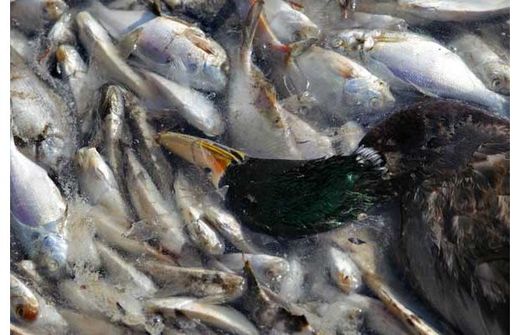
"It seems a little strange," said Mike Stoyshin, who noticed the mass of dead gizzard shad in the river while going for a walk Tuesday evening.
When he got a little closer, he realized there were several dead mallard and merganser ducks floating among the fish.
"I know that everybody says the shad die off every year but a dozen ducks dead in the same pile is kind of concerning," said Stoyshin.
Ministry of Natural Resources biologist Andy Cook dispatched a team from the Wheatley MNR office after being notified of the dead waterfowl by The Star Wednesday morning.
Seven mallards, one merganser and two Canada geese carcasses were retrieved and will be sent to the Canadian Co-operative Wildlife Health Centre in Guelph for analysis.
While Cook avoided prejudging the test results, he said the fish and waterfowl likely died for the same reason: the harsh winter temperatures this year.
"With the severity of the winter, their normal food sources may be inaccessible," said Cook.
"Certainly the fields, with a hard freeze, the grains they would normally feed on are not accessible. This has been one of the more severe winters we've had in several years."
Cook said the Canadian Wildlife Service has been noting many species of ducks they have banded are appearing extremely malnourished this year.
Ducks do not normally eat shad or any other fish during the winter, preferring grains. But with the hard, frozen ground that food source is likely less available.
In Michigan, the Department of Natural Resources and Environment is analyzing gizzard shad that have died in similar mass kills this winter. There is a disease that has been appearing in gizzard shad known as viral hemorrhagic septicemia that is found in fish in Europe, Japan and the coasts of North America.
The disease, which was first identified in Ontario in Lake Ontario in 2005, is found in several species including shad.
Michigan authorities are awaiting test results on the fish from the University of Michigan.
Young shad are also susceptible to temperature extremes.
Cook said there is nothing to indicate anything has happened to the fish or the ducks that is potentially harmful to humans.
Daily Ganatchio Trail jogger George Schoebe, 77, was taken aback by the quantity of dead fish and ducks in the water, and the odour.
"It's terrible," said Schoebe.
"I've never seen that before. So many dead fish, all at the same time. There are also dead ducks on top of the fish. It has been getting worse and worse. More and more dead fish. I never noticed that before. It smells."
The mass of dead fish and waterfowl is being held at the mouth of the river by a dam of ice that is likely to melt in the coming days, then allowing the fish and ducks to float into the Detroit River.
Cook said the death of so many ducks may be alarming but is not considered "catastrophic."
"That's certainly a die-off but it's not at a catastrophic level," said Cook.
"Generally large bird die-offs that occur from eating fish occur during the summer as a result of botulism."
Ward 7 Coun. Percy Hatfield said there's not much the city can do in such a situation.
"It's unfortunate, and it can be alarming, but it is nature," said Hatfield.



Reader Comments
to our Newsletter